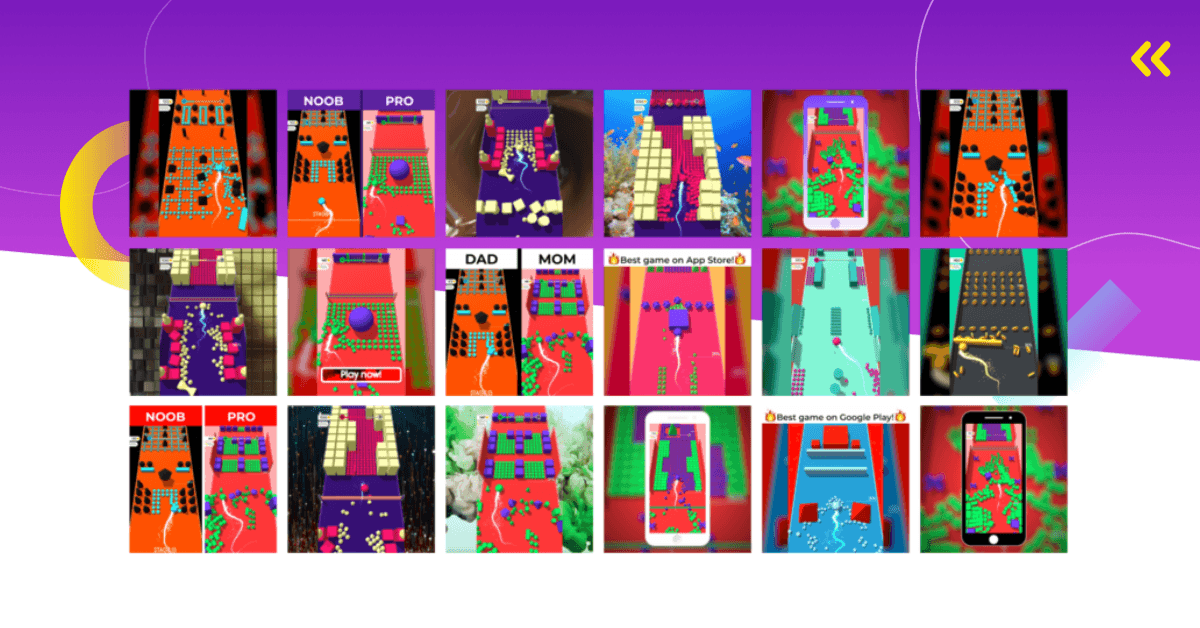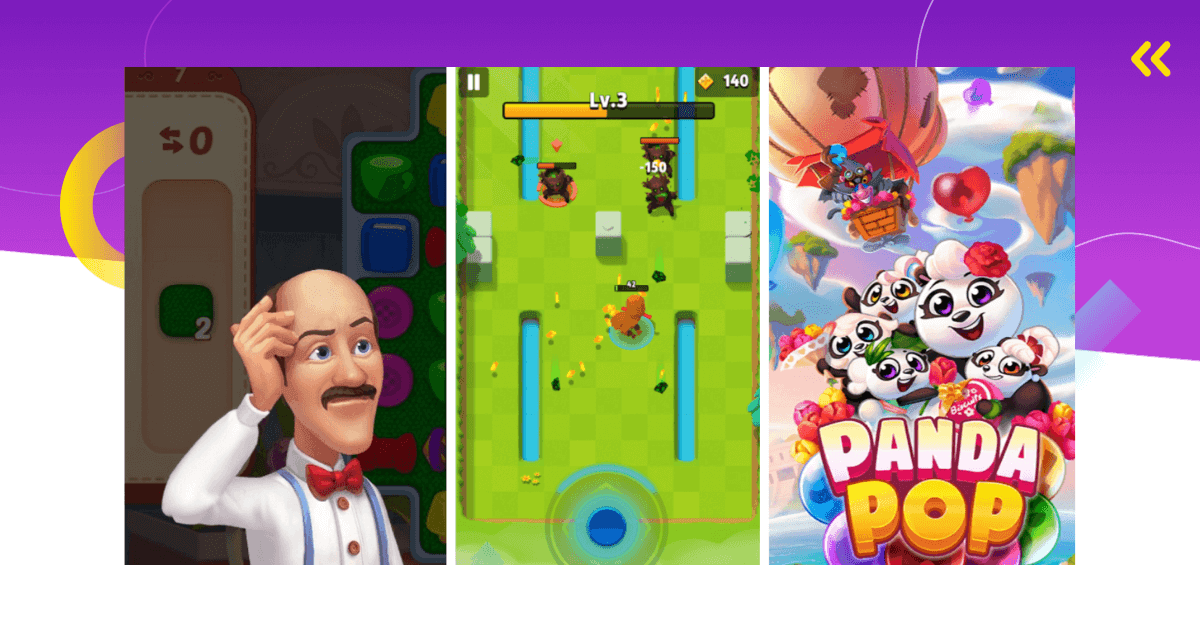Do you want to acquire more users for a mobile game by improving the effectiveness of your ad campaigns? Are you looking for a systematic and structured way to do so? You’re in for a treat. Facebook Gaming’s Creative Prototyping is just what you’re looking for. It will teach you how to test ad creatives for mobile games to maximize your campaigns’ performance.
To help you get started, we’ve summarized the most important points from this Facebook Gaming guide.
It’s based on four steps – ask, make, learn, and adapt. Here’s an overview of each one.
1. Ask
The first step is all about asking the right questions.

Learning Agenda
To begin this process, Facebook Gaming recommends you create a learning agenda. Put simply, it’s a program of what you want to learn during the creative process.
It helps you get a better idea of what’s working and why. That, in turn, can significantly maximize the effectiveness of your ad campaign and overall user acquisition strategy.
Furthermore, learning agendas allow you to have a systematic approach to improving campaigns.
First, you need to take into consideration what you already know about a specific creative challenge you want to tackle. The information that you do know may come from past or current ad campaigns and their performance, research, or general mobile game market trends. Then add what you don’t know to the mix – there should be a balance between the two.
Furthermore, Facebook Gaming advises that developers should prioritize big-picture learnings that can help them with their overall strategy over short-term ones, based on specific campaigns.

Above, you can see an example of a learning agenda from Facebook Gaming’s report. You can see here that a learning agenda can be useful for many different parts of creative development – positioning, concepts, and execution.
Crafting a Hypothesis
After defining what it is that you want to learn, the next step is defining the hypothesis you want to test.
Put simply, a hypothesis is an idea or an assumption made so that it can be tested. In other words, it’s a prediction of an outcome based on known facts that is yet to be proven.
For example, you might have an idea about which creative concept might work based on what you already know. This is the type of hypothesis you’ll want to test and see if your prediction was correct.
Keep in mind that crafting a hypothesis is crucial for your experiment. Starting with an unclear hypothesis can derail everything, and you won’t get the results you need.
Facebook Gaming recommends asking multiple “w” questions.
For example:
- Why are you doing this experiment? In other words, what do you want to accomplish with it?
- Who is your target audience? What do you want to learn about this group?
- Which KPI is the most important to you? What is your goal in terms of trackable metrics?
- What is the variable you want to test?

Above, you can see an example hypothesis from Facebook Gaming, based on the aforementioned “w” questions.
The Creative Prototyping guide also includes a case study for Babil Games’ Strike of Nation. Here you can see how crafting a hypothesis to test works for a real game.
Position
“What is the correct way to introduce the Strike of Nations brand and what is the long run influence?”
Concept
“Do concepts that educate the viewer perform better than those that celebrate the action? What is the impact of human-focused concepts vs. zombies? Or both?”
Execution
“How should we incorporate branding? I.e., overlay, at the front, at back, all of the above? What is the right way to build live-action and gameplay together? I.e., split screens, straight cut?”
“Do CTAs work? Are persistent CTAs better? Just on the end card? What moment is right to include? Do we match CTA to the scene?”
2. Make
Now it’s time to move on over to creative production. But remember, all the creative assets need to be based on the hypotheses you decided to test.
It’s important to reduce the number of variables as much as possible to not compromise the experiment and make it confusing. Furthermore, at this stage, it’s not about crafting the final campaign assets but rather prototypes that will help you learn how your final campaign should look like.

How to Craft Mobile Game Creatives
Here are some basic guidelines on how to create video ads for your mobile game. By following these five simple steps, you’ll end up with high-quality creative assets.
1. Open with an Attention-Grabbing Moment
Imagine a person scrolling on their phone. There are hundreds of posts and ads they encounter each time they engage with social media apps.
That means you only have a couple of seconds until they scroll past your ad.
So how can you make your creative stand out and grab their attention?
Start with a bang.
You need to open with an impactful moment that will keep users glued to their screens. Take a look at your competitors’ ads and try to come up with an opening scene that will make your creative stand out.
Additionally, try to appeal to player motivations right away – this will pique their interest.
2. Highlight Your Brand
Facebook Gaming recommends including a logo or other branding in the first couple of seconds of the creative.
That way, you can establish your brand and be proud of it. Additionally, if you already have some fans who recognize your brand, they might continue watching because of familiarity.
However, don’t think you need to go big and bold with branding. You can casually insert your logo as a part of the scene or add it during a quick transition. That’s enough to make an impression.

3. Demonstrate Gameplay
The majority of your ad should consist of edited gameplay footage. You can add other assets, as well as captions, effects, sounds, and music. But nevertheless, the gameplay footage should truthfully represent the gameplay experience.
In a video creative, you need to relate to viewers what it’s like to play your game, i.e., how fun, exciting, and captivating it is. It’s obvious how this can create interest in the game.
That way, the ad viewers will know exactly what to expect if they choose to download the game.
4. Make Your Message Clear
The edited gameplay footage should tell a story or deliver some kind of message. Throwing together random gameplay scenes won’t do much for your creative. It won’t make any sense.
Make sure the gameplay footage is there for a reason. For example, you might want to show how relaxing your game is. All of the scenes need to demonstrate that.
Or perhaps you want to show how to make progress in the game and earn rewards. Gameplay scenes demonstrating that, along with captions and other effects, can help you make that message clear.
Furthermore, it can be beneficial to consider player motivations when crafting your creative. This will help you develop a clear message and storyline that targets a specific group of players and make it easier to test ad creatives.

5. Add a CTA at the End
So you’ve completed steps one through four of how to test ad creatives, and your creative now looks superb. However, there’s one last thing missing – a call to action.
Since you’ve already put all this effort into creating an engaging creative, it would be a shame to miss the opportunity to invite people to download your game. After all, this is what it’s all about – conversion is the end goal.
You might be tempted to use a simple “Play now” or “Download for free” CTA. However, it’s advised you avoid such generic messages.
Instead, write a personalized call to action, i.e., one that directly relates to your game. For example, “Start building now!”, “Join millions of players!” or “Choose your story”.

Isolate a Creative Variable
When working on ad creatives that will help you prove your hypothesis, you must visually isolate the creative variable you want to test. All other ad elements should remain the same.
By doing this, you’ll be able to correctly attribute the difference in performance.
There’s also the question of creative differentiation.
According to Facebook Gaming, “when designing tests for “position” or “concept” we find that the creative visuals are more distinctly different from each other, and when designing for “execution”, we often see there’s less visual distinction.”
Here are some examples from the Creative Prototyping report.

Distinct Creatives
Above, you can see an example of distinct creatives from Goodgame’s Big Farm: Mobile Harvest.
On the left is a business-as-usual creative (BAU), and on the right, there are four very different creatives.
Each is based on a different player motivation (relaxation, power, expertise, and self-expression). That’s because the goal of this experiment was to test what motivation appealed to different audiences. To do that, it was required to demonstrate different game features.

Similar Creatives
The experiment Gram Games has done for Merge Dragons is a bit different. Their goal was to test how different narratives and storylines affect ad performance. Because of that, all creatives were very similar. The only variable that changed was the story composition, not its core elements.

Bonus: Strike of Nations Case Study
Facebook Gaming included another interesting case study for Babil Games’ Strike of Nations.
The publisher wanted to test whether including a logo and different branding placements would impact the performance of their ad creatives. To do that, they made four different creatives (no branding, logo & border, end card & logo, and integrated).
Notice that each ad creative looks different. However, the composition, length, and aspect ratio are the same. That way, the only variable is branding, which is the purpose of this test.
All these examples show you how to create assets to test different hypotheses and isolate a creative variable. Use them to do your own experiments.

3. Learn
In this section, you’ll learn how to design your test and analyze its results. The test will either prove or disprove your hypothesis.
You have two options.
Design a test that will make the results as accurate and reliable as possible. Or you can prioritize the reduction in cost and time it takes to run it.
The two testing choices are described in the image above.
Best Practices for Testing
Here are the best practices Facebook Gaming recommends you follow when testing.
Consistency is Key
Testing should be done in a very clear and systematic manner. Most importantly, you need to isolate the variable you’re testing, as mentioned before. Creatives need to be as similar as you can make them, except for that variable.
Use the Same Set Up for Each Test Group
Facebook Gaming recommends that you “use the same budget, bid, targeting, optimization and time period for each test group.”
Avoid Edits
In order to be consistent and ensure that your test is accurate, it’s best to avoid edits. If you, however, absolutely must make an edit, do it to all test groups at the same time.
Select the Control Creative Wisely
The control creative mustn’t run anywhere else while you run the test, as additional learning can compromise the test. Thus, you should pause it elsewhere until the test is completed.

Choose a Test Methodology
A test methodology should be selected based on your hypothesis as well as the type of creatives you’re testing.
Most of the time, a simple A/B test is the best option. However, there are some exceptions.
According to Facebook Gaming, if the creatives you’re testing are very similar, the auction selection test is the most appropriate. The same goes if you’re testing a large number of creatives to find out which ones work better.
Furthermore, if you have creatives that might reach different audience groups, a conversion lift test is the best option.

Analyze Test Results
Once you’ve run the test, it’s time to analyze its results. Start by differentiating primary and secondary learnings.
In the image above, you can see a detailed explanation for both from the Creative Prototyping guide.
Don’t Ignore Secondary Learnings
Some creatives won’t work for primary metrics. However, that doesn’t mean you can’t learn something from them. There might be secondary learnings that are worth exploring.
Facebook Gaming recommends you ask these questions.
- Did the creatives reach a new audience?
- Did the creatives entice a new audience to purchase?
- Was there a positive impact on brand awareness? Did creatives make you stand out from the competition?
- Did the new assets have a positive influence on user retention? Have some of them converted players who are more engaged with the game?
- Do the creatives appeal to a specific demographic?
- Did some creatives acquire players who are likely to have a higher LTV?
The questions above are a great starting point. However, feel free to investigate further and ask even more questions.

Bonus: Case Study
Continuing with the Babil Games’ experiment for Strike of Nations, Facebook Gaming guide shows that the end card and logo creative was the winner.
According to the case study, it “had a 24% lower CPI and 27% lower cost per registration” than the no logo creative. This was the primary metric. However, it also boosted registration volume and purchases (secondary metric).

4. Adapt
We’ve come to the final step of our guide on how to test ad creatives.
Now it’s time to discuss your learnings and think about how you’ll implement new changes in your advertising campaigns.
Above, you can see a list of questions you should ask.
Make a Creative Leap
Making a creative leap means taking actions based on what you’ve learned so far. In other words, use what you learned through the experiment to improve your ad campaigns.
How to Test Ad Creatives: A Summary
I’ll leave you with some reasons why you need to test ad creatives.
Primarily, testing ensures you run ad campaigns that are relevant and engaging to your target audience and true to your brand. It improves the performance of your ad creatives which results in more conversions.
Through the testing process, you’re learning valuable info about your audience, i.e., interests, behaviors, more detailed demographics data, etc. That, in turn, improves your ad targeting and informs other decisions related to game updates and monetization.
Furthermore, it saves you money and time – you’ll not waste it on campaigns that don’t work. Budgeting becomes easier as testing will show you exactly how much you need to spend.
And remember, you can repeat the steps detailed in this guide and test new hypotheses. This type of systematic approach to testing can be beneficial for all new ideas you want to try out.
If you have any questions about this process, reach out in the comments below!





![Mobile App Market Growth, Size, and Share [2025 Report]](/static/231d355e4558e7604b3988968bd48b56/0ccb9/mobile-app-market.png)

Comments